The Doctor Who TV movie was first transmitted in May 1996. It’s a story that paved the way for a TV return – even if it did take nine years.
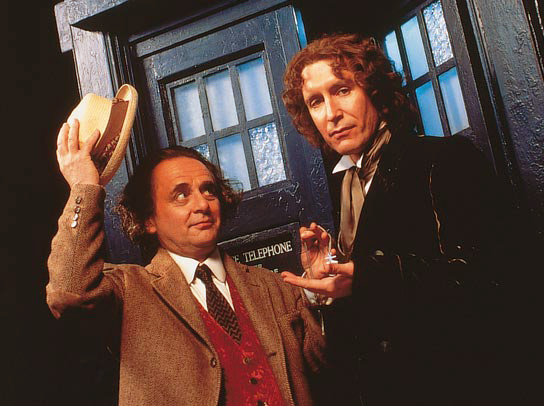
The Doctor Who TV movie was a co-production between Universal, Fox and the BBC. Filmed in Canada, it was hoped that it would spawn a brand new series of adventures for the Eighth Doctor, which would be produced across the Pond. Alas, these plans never came to fruition, and for a long time it was felt that the TV movie would be the last live action Doctor Who we ever saw.
However, seven years later the BBC announced that it had commissioned a brand new series of Doctor Who. It was to be written by Russell T Davies and produced by BBC Wales, with transmission planned for the spring of 2005. The Doctor Who TV movie, it seemed, was now sandwiched between two eras – the Classic and the New.
And even though the Doctor Who TV movie is markedly different in tone and style to its preceding adventures, it had a significant influence on the version that was made in 2005.
For a start, the Ninth Doctor‘s title sequence is reminiscent of the one employed in the Doctor Who TV movie. In both cases, we see the TARDIS tumbling through the time vortex as the names of the main actors hurtle towards the camera. (Both of these sequences are, in turn, similar to the ‘slit-scan’ titles used during the Fourth Doctor’s era, where the TARDIS is seen travelling down a tunnel.) What the 2005 revival omits, however, are the funky asteroids and space rocks seen in the Doctor Who TV movie, although it does keep the revolving logo.
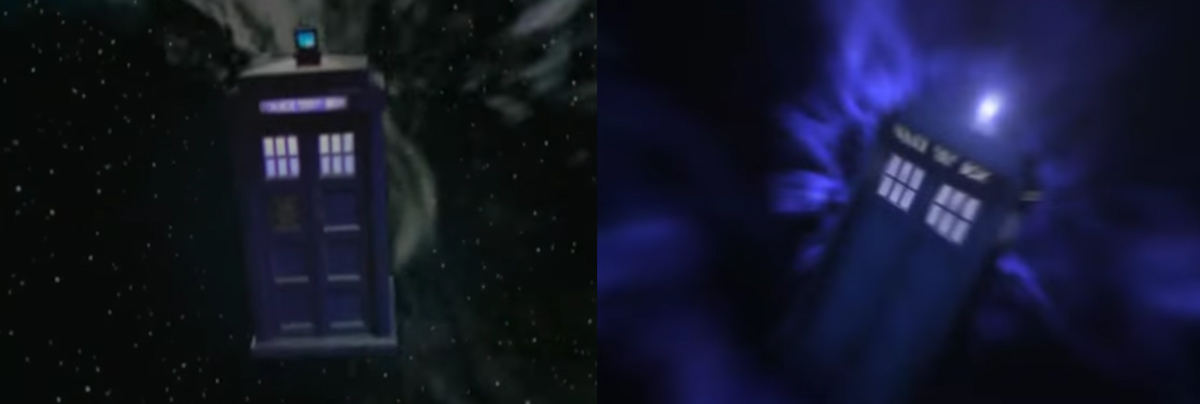
Similarly, we have the TARDIS itself. The Doctor Who TV movie was the first story in the show’s history to introduce a completely redesigned console room. (There was an alternative used during the Fourth Doctor’s era, but this was in a different part of the TARDIS. The main console room remained intact.) In this instance, the Eighth Doctor has acquired a whole new interior. Gone is the floodlit ‘lab’ with its roundels, and even the cylindrical time rotor has been replaced. The TARDIS console now consists of a solid glass tube that rises into the ceiling, melding into wires and girders.
This is a look that the 2005 series borrows from the Doctor Who TV movie. Although the console itself is different, the larger glass time rotor is retained, rising and falling in a similar fashion to the Eighth Doctor’s machine, and tinted green instead of blue. The console room, meanwhile, maintains the moodily-lit look from the TV movie, bathed in shadows and pulsing lights. But at the same time, it loses the regal, stately-home look of the Eighth Doctor‘s TARDIS, instead focusing on the more ‘machine’ aspects of the Doctor’s vehicle.
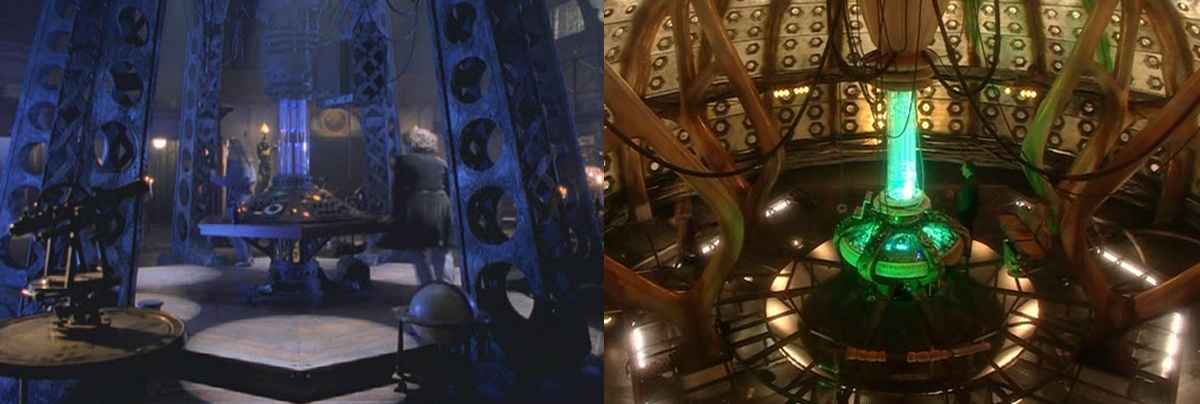
I say “the Eighth Doctor’s vehicle” – but in truth, the Doctor Who TV movie opens with the Seventh Doctor at the controls. This is a fleeting appearance, though; the Seventh Doctor is killed upon arrival in San Francisco, and quickly regenerates into a new body.
It is here that the 2005 series and the Doctor Who TV movie differ. Indeed, Russell T Davies chose to go in completely the opposite direction, believing that a regeneration would be too confusing for first time viewers. Moreover, he wanted the Christopher Eccleston to have a fresh start and hit the ground running. Thus, viewers did not get to see how McGann’s Doctor died until ‘The Night of the Doctor’ in 2013.
That being said, Paul McGann indicated that he would have returned to shoot a regeneration in 2005, had he been asked. And speaking personally, the Doctor Who TV movie was the first Doctor Who story I ever saw, and it didn’t confuse me at all. Indeed, I found the idea of an alien being able to swap his body one of the most intriguing aspects of the show, and it firmly cemented my interest in a series that I am still watching (and writing about!) 24 years later.
But I digress.
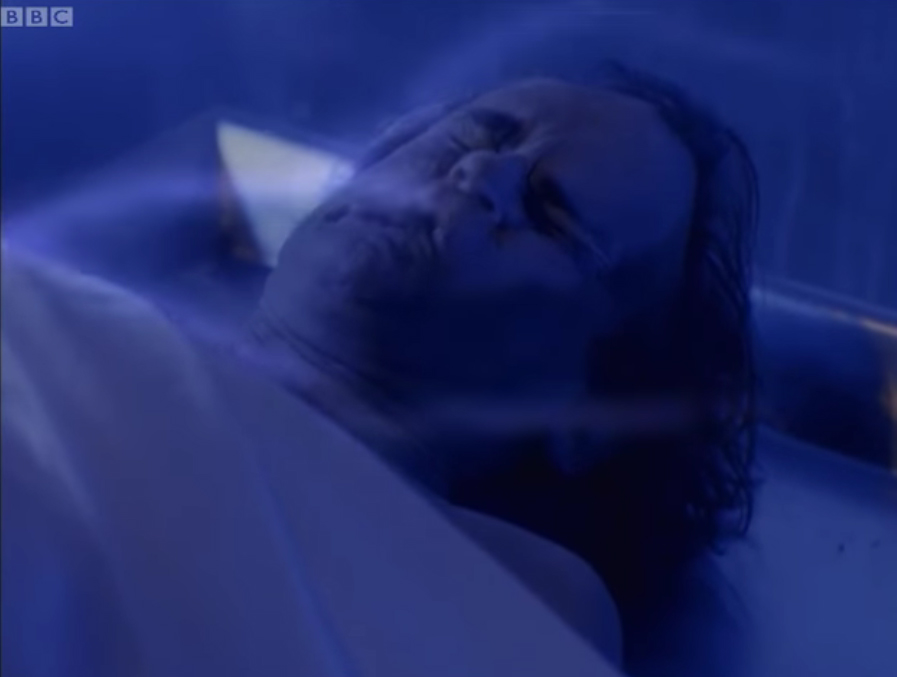
One final way the Doctor Who TV movie influenced the 2005 series is in its romantic components. Prior to 1996, the Doctor had always been something of a sexual enigma, showing little-to-no romantic interest in anyone. (There are hints of a love interest in the 1964 story ‘The Aztecs,’ but it doesn’t really develop.)
However, in the Doctor Who TV movie, the Doctor and his ‘companion’ Grace are portrayed as a couple. At one point, Grace says, “Oh great – I finally meet the right guy and he’s from another planet.” And then there is their goodbye scene, where they enjoy a brief kiss against a backdrop of fireworks. Undoubtedly, the Doctor had developed strong feelings towards another person – something that was a first for the series.
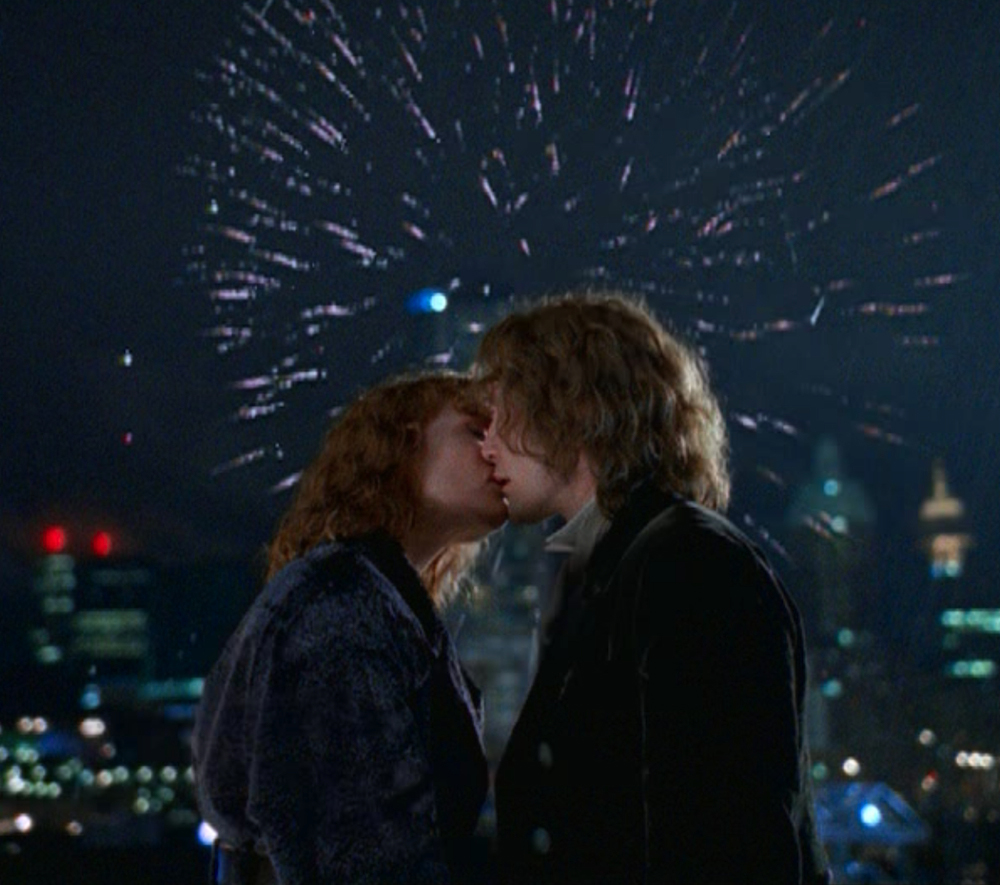
And this is a thread that’s picked up in 2005. The romance between the Doctor and Rose is only hinted at, to begin with. They do share a kiss – initiated by the Doctor – but it was necessary to save Rose’s life. (I mean, what else are you supposed to do when your friend absorbs all the energy of the time vortex?!) Of course, by the time the two characters are forced to say goodbye, their relationship has advanced significantly. Rose even tells the Doctor that she loves him, and it’s strongly suggested that he’s about to say it back – only for the walls of the universe to close before he can finish his sentence.
And prior to the Doctor Who TV movie, such a relationship would never have been considered. Indeed, the producer John Nathan-Turner (who ran the show in the 80s) fought hard to crush any suggestion that there was “hanky panky” going on in the TARDIS, insisting that the Fifth Doctor’s companions be fully clothed from head to foot, lest eyebrows be raised.
But the TV movie showed that romance could be handled in a way that preserved the Doctor’s character, without tearing a hole in the fabric of the space-time continuum.
But would the revived series have been the same had it not been for the Doctor Who TV movie? It’s hard to say. Certainly, Russell T Davies and his team injected a huge amount of creativity into their version (whilst also drawing from other sources, such as the Virgin novels) so it would still undoubtedly have been a ratings success.
At the same time, the importance of the TV movie cannot be underestimated. It laid much of the groundwork for the revival that followed in 2005, and today it neatly bridges the gap between two significant eras in the Doctor’s life.
How else do you think the Doctor Who TV movie influenced the 2005 series? Let me know in the comments below.

Seventh Doctor jumper – order now from the Lovarzi shop!
Shop on Amazon
Latest posts…
- Doctor Who: Ranking all of the Auton stories
- 3 problems faced by Doctor Who showrunners
- Doctor Who: Ranking all of the classic Sontaran stories
- Is Doctor Who Season 13 the pinnacle of the Tom Baker era?
- Doctor Who: Is Wild Blue Yonder a modern day classic?


WHEN THE 1996 PILOT WAS BROADCAST, THE DAY WAS MY 25TH BIRTHDAY, I HAD, HOWEVER, ALREADY SEEN THE STORY ON BBC VHS VIDEO CASSETTE EARLIER IN THE MONTH. I SEEM TO RECALL THERE WAS A LITTLE PROBLEM WITH THE CERTIFICATE: IT WAS INITIALLY ADVERTISED WITH A ’15’, THEN ALTERED TO A ’12’.
THE VERSION TRANSMITTED ON BBC-1 AT ‘8.30pm’ WAS IDENTICAL TO THE VERSION ON BBC VIDEO.
IN NOVEMBER 1999, THE STORY WAS REPEATED ON BBC-2 LATE ONE NIGHT AS PART OF A ‘DOCTOR WHO NIGHT’ PRESENTED BY TOM BAKER, ALTHOUGH THIS VERSION WAS A DIFFERENT EDITION TO THE 1996 TRANSMISSION.
‘THE TV MOVIE’, AS IT IS USUALLY CALLED, WAS AN EXPENSIVE BEGINNING FOR A SERIES THAT WAS NEVER MADE. PERSONALLY, I DOUBT PAUL MCGANN WOULD HAVE STAYED IN THE ROLE FOR FIVE YEARS.
IN 1996, JON PERTWEE SUDDENLY PASSED AWAY…